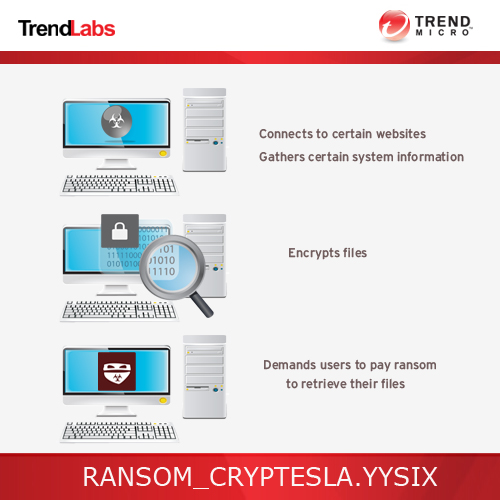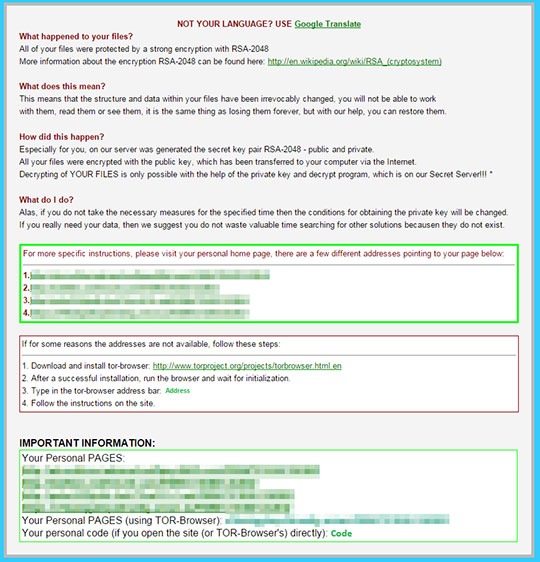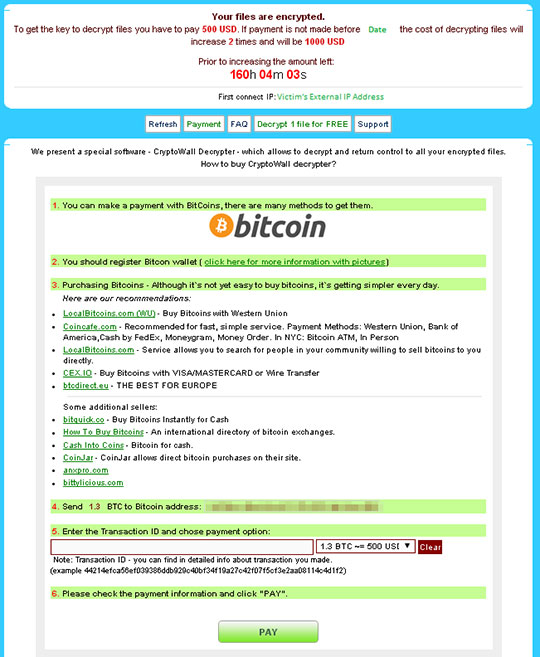RANSOM_CRYPTESLA.YYSIX
Ransom:Win32/Tescrypt.A (Microsoft), Ransom.TeslaCrypt (Malwarebytes)
Windows


Threat Type: Trojan
Destructiveness: No
Encrypted: Yes
In the wild: Yes
OVERVIEW
This malware is related to the compromised blog page of the UK news media website, "The Independent." Users who visited the hacked page are redirected to sites hosting Angler Exploit Kit. As such, it puts user systems at risk of being infected with this TeslaCrypt Ransomware.
To get a one-glance comprehensive view of the behavior of this Trojan, refer to the Threat Diagram shown below.

This Trojan arrives on a system as a file dropped by other malware or as a file downloaded unknowingly by users when visiting malicious sites.
It modifies the Internet Explorer Zone Settings.
It connects to certain websites to send and receive information. It deletes itself after execution. It gathers information and reports it to its servers.
TECHNICAL DETAILS
Arrival Details
This Trojan arrives on a system as a file dropped by other malware or as a file downloaded unknowingly by users when visiting malicious sites.
Installation
This Trojan drops the following copies of itself into the affected system and executes them:
- %Application Data%\{5 random character}-bc.exe
(Note: %Application Data% is the Application Data folder, where it usually is C:\Documents and Settings\{user name}\Application Data on Windows 2000, Windows Server 2003, and Windows XP (32- and 64-bit); C:\Users\{user name}\AppData\Roaming on Windows Vista (32- and 64-bit), Windows 7 (32- and 64-bit), Windows 8 (32- and 64-bit), Windows 8.1 (32- and 64-bit), Windows Server 2008, and Windows Server 2012.)
It adds the following mutexes to ensure that only one of its copies runs at any one time:
- 2134-1234-1324-2134-1324-2134
Autostart Technique
This Trojan adds the following registry entries to enable its automatic execution at every system startup:
HKEY_CURRENT_USER\Software\Microsoft\
Windows\CurrentVersion\Run
Acronis = "%Application Data%\{5 random character}-bc.exe"
Other System Modifications
This Trojan adds the following registry keys:
HKEY_CURRENT_USER\Software\zsys
HKEY_CURRENT_USER\Software\{installation ID}
It adds the following registry entries:
HKEY_LOCAL_MACHINE\SOFTWARE\Microsoft\
Windows\CurrentVersion\Policies\
System
EnabledLinkConnections = 1
HKEY_CURRENT_USER\Software\{installation ID}
data = {encryption information}
HKEY_CURRENT_USER\Software\zsys
ID = {installation ID}
Process Termination
This Trojan terminates the following processes if found running in the affected system's memory:
- taskmgr
- procexp
- regedit
- msconfig
- cmd.exe
Web Browser Home Page and Search Page Modification
This Trojan modifies the Internet Explorer Zone Settings.
Dropping Routine
This Trojan drops the following files:
- %User Profile%\Documents\recover_file_{9 random letters}.txt
- %Desktop%\Howto_RESTORE_FILES.txt
- %Desktop%\Howto_RESTORE_FILES.html
- %Desktop%\Howto_RESTORE_FILES.bmp
(Note: %User Profile% is the current user's profile folder, which is usually C:\Documents and Settings\{user name} on Windows 2000, XP, and Server 2003, or C:\Users\{user name} on Windows Vista and 7.. %Desktop% is the desktop folder, where it usually is C:\Documents and Settings\{user name}\Desktop in Windows 2000, Windows Server 2003, and Windows XP (32- and 64-bit); C:\Users\{user name}\Desktop in Windows Vista (32- and 64-bit), Windows 7 (32- and 64-bit), Windows 8 (32- and 64-bit), Windows 8.1 (32- and 64-bit), Windows Server 2008, and Windows Server 2012.)
Other Details
This Trojan connects to the following URL(s) to get the affected system's IP address:
- http://myexternalip.com/raw
It connects to the following website to send and receive information:
- http://{BLOCKED}academy.com/media/misc.php
- http://crown.{BLOCKED}io.pl/media/misc.php
- http://{BLOCKED}lbrass.no/media/misc.php
- http://{BLOCKED}asphalt.com/media/misc.php
- http://{BLOCKED}tup.com/media/misc.php
- http://{BLOCKED}randes.com/media/misc.php
It encrypts files with the following extensions:
- .3fr
- .accdb
- .ai
- .arch00
- .arw
- .bar
- .bay
- .bc6
- .bc7
- .big
- .bkf
- .bkp
- .blob
- .cas
- .cdr
- .cer
- .cfr
- .cr2
- .crt
- .crw
- .css
- .dazip
- .db0
- .dba
- .dbf
- .dcr
- .der
- .desc
- .dmp
- .dng
- .doc
- .docm
- .docx
- .dwg
- .dxg
- .eps
- .erf
- .esm
- .ff
- .flv
- .fos
- .fpk
- .fsh
- .gdb
- .gho
- .hkdb
- .hkx
- .hplg
- .hvpl
- .ibank
- .icxs
- .indd
- .itdb
- .itl
- .itm
- .iwd
- .jpe
- .jpeg
- .jpg
- .js
- .kdb
- .kdc
- .kf
- .layout
- .lrf
- .lvl
- .m2
- .m3u
- .map
- .mcmeta
- .mdb
- .mdbackup
- .mddata
- .mdf
- .mef
- .menu
- .mlx
- .mov
- .mpqge
- .mrwref
- .ncf
- .nrw
- .ntl
- .odb
- .odc
- .odm
- .odp
- .ods
- .odt
- .orf
- .p12
- .p7b
- .p7c
- .pdd
- .pef
- .pem
- .pfx
- .pkpass
- .png
- .ppt
- .pptm
- .pptx
- .psd
- .psk
- .pst
- .ptx
- .py
- .qdf
- .qic
- .raf
- .raw
- .rb
- .rim
- .rofl
- .rtf
- .rw2
- .rwl
- .sb
- .sid
- .sidd
- .sidn
- .sie
- .sis
- .snx
- .sr2
- .srf
- .srw
- .sum
- .svg
- .syncdb
- .t12
- .t13
- .tax
- .tor
- .txt
- .vcf
- .vdf
- .vfs0
- .vpk
- .vpp_pc
- .vtf
- .w3x
- .wb2
- .wmo
- .wotreplay
- .wpd
- .wps
- .x3f
- .xf
- .xlk
- .xls
- .xlsb
- .xlsm
- .xlsx
- .xxx
- .zip
- .ztmp
- wallet
It opens the following files:
- dropped %Desktop%\Howto_RESTORE_FILES.txt
- dropped %Desktop%\Howto_RESTORE_FILES.html
- dropped %Desktop%\Howto_RESTORE_FILES.bmp
(Note: %Desktop% is the desktop folder, where it usually is C:\Documents and Settings\{user name}\Desktop in Windows 2000, Windows Server 2003, and Windows XP (32- and 64-bit); C:\Users\{user name}\Desktop in Windows Vista (32- and 64-bit), Windows 7 (32- and 64-bit), Windows 8 (32- and 64-bit), Windows 8.1 (32- and 64-bit), Windows Server 2008, and Windows Server 2012.)
It deletes itself after execution.
It gathers the following information and reports it to its servers:
- Infection status
- Encryption key
- Bitcoin address
- Total size of encrypted files
- Malware version
- OS information
- Tor2web gateway used
- IP address
- Installation ID
NOTES:
It deletes shadow copies by executing the following command:
vssadmin.exe delete shadows /all /Quiet
It appends the extension .vvv to the file name of the encrypted files. It avoids encrypting files in the following folders:
- Windows
- Program Files
- All User Application Data
It drops how_recover+{3 random letters}.html and how_recover+{3 random letters}.txt to the folders where the files are encrypted.


It encrypts files in all fixed, removable, and network drives and shares.
SOLUTION
Step 1
Before doing any scans, Windows XP, Windows Vista, and Windows 7 users must disable System Restore to allow full scanning of their computers.
Step 2
Note that not all files, folders, and registry keys and entries are installed on your computer during this malware's/spyware's/grayware's execution. This may be due to incomplete installation or other operating system conditions. If you do not find the same files/folders/registry information, please proceed to the next step.
Step 3
Delete this registry value
Important: Editing the Windows Registry incorrectly can lead to irreversible system malfunction. Please do this step only if you know how or you can ask assistance from your system administrator. Else, check this Microsoft article first before modifying your computer's registry.
- HKEY_CURRENT_USER\Software\Microsoft\Windows\CurrentVersion\Run
- Acronis = "%Application Data%\{5 random character}-bc.exe"
- HKEY_LOCAL_MACHINE\SOFTWARE\Microsoft\Windows\CurrentVersion\Policies\System
- EnabledLinkConnections = "1"
Step 4
Delete this registry key
Important: Editing the Windows Registry incorrectly can lead to irreversible system malfunction. Please do this step only if you know how or you can ask assistance from your system administrator. Else, check this Microsoft article first before modifying your computer's registry.
- In HKEY_CURRENT_USER\Software
- zsys
- zsys
- In HKEY_CURRENT_USER\Software
- {Installation ID}
- {Installation ID}
Step 5
Search and delete these files
- %User Profile%\Documents\recover_file_{9 random letters}.txt
- %Desktop%\Howto_RESTORE_FILES.txt
- %Desktop%\Howto_RESTORE_FILES.html
- %Desktop%\Howto_RESTORE_FILES.bmp
- how_recover+{3 random letters}.html
- how_recover+{3 random letters}.txt
Step 6
Reset Internet security settings
Step 7
Scan your computer with your Trend Micro product to delete files detected as RANSOM_CRYPTESLA.YYSIX. If the detected files have already been cleaned, deleted, or quarantined by your Trend Micro product, no further step is required. You may opt to simply delete the quarantined files. Please check this Knowledge Base page for more information.
NOTES:
Restore encrypted files from backup.
Did this description help? Tell us how we did.


